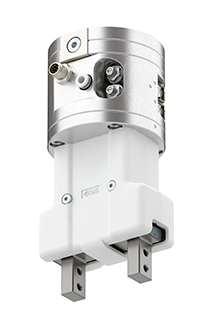Pneumatic grippers: powerful and reliable solutions for industrial automation
Share
Gripping solutions play a central role in the world of industrial automation. Pneumatic grippers have established themselves as a proven and versatile technology. They are used in a wide range of industries, from the automotive industry to packaging and food production to electronics manufacturing. But what exactly makes pneumatic grippers so special and why are they the preferred choice for many companies?
How do pneumatic grippers work?
Pneumatic grippers use compressed air to perform the gripping function. They are driven by cylinders that, depending on the design, move one or more gripping jaws that securely grip and release an object. These grippers can have different shapes, such as parallel or angle grippers, and are selected depending on the requirements of the object to be gripped.
By using compressed air, pneumatic grippers are able to generate high forces in a relatively simple manner. This makes them particularly suitable for applications that require powerful and fast handling, such as gripping heavy or robust components.
Advantages of pneumatic grippers
-
High gripping force: One of the biggest advantages of pneumatic grippers is their ability to generate high gripping forces, making them ideal for heavy or stable objects. These grippers are robust and can be used in demanding environments.
-
Reliability: Pneumatic grippers are extremely reliable and low-maintenance. The simple design and the proven principle of compressed air application ensure a long service life and low maintenance requirements.
-
Speed and efficiency: In fast manufacturing processes, such as those typical in the automotive or packaging industries, pneumatic grippers offer fast and precise handling. The cycle time is short, which enables higher productivity.
-
Cost efficiency: Compared to other technologies, pneumatic grippers are often cheaper to purchase and operate. Pneumatic systems can be integrated cost-effectively, especially in existing production environments where compressed air is already available.
Applications of pneumatic grippers
Pneumatic grippers are used in a variety of industries and applications:
- Automotive industry: Here they are often used in assembly to safely grip and move heavy components such as body parts or engines.
- Packaging industry: Pneumatic grippers are ideal for quickly and efficiently gripping cartons, bottles or other packaging in production lines.
- Electronics manufacturing: In the electronics industry, pneumatic grippers are used to precisely handle sensitive components without damaging them.
- Food production: Special, food-safe pneumatic grippers that meet hygienic requirements are also used in the food industry.
Challenges and new developments
While pneumatic grippers offer many advantages, there are also challenges. One of these is the precise handling of delicate or complex-shaped objects. Electric grippers offer more flexibility in this area. However, pneumatic gripper manufacturers are increasingly developing innovative solutions that improve precision and control, such as adjustable gripping forces or integrated sensors to monitor position and force.
Conclusion
Pneumatic grippers remain one of the most popular gripping technologies in industrial automation. They offer an ideal combination of power, speed and reliability that is essential for numerous industries. With ongoing technological improvements, pneumatic grippers will continue to play an important role in automation in the future, covering increasingly demanding applications.
If you are looking for a powerful and cost-effective gripping solution for your production, a pneumatic gripper could be the right choice.

